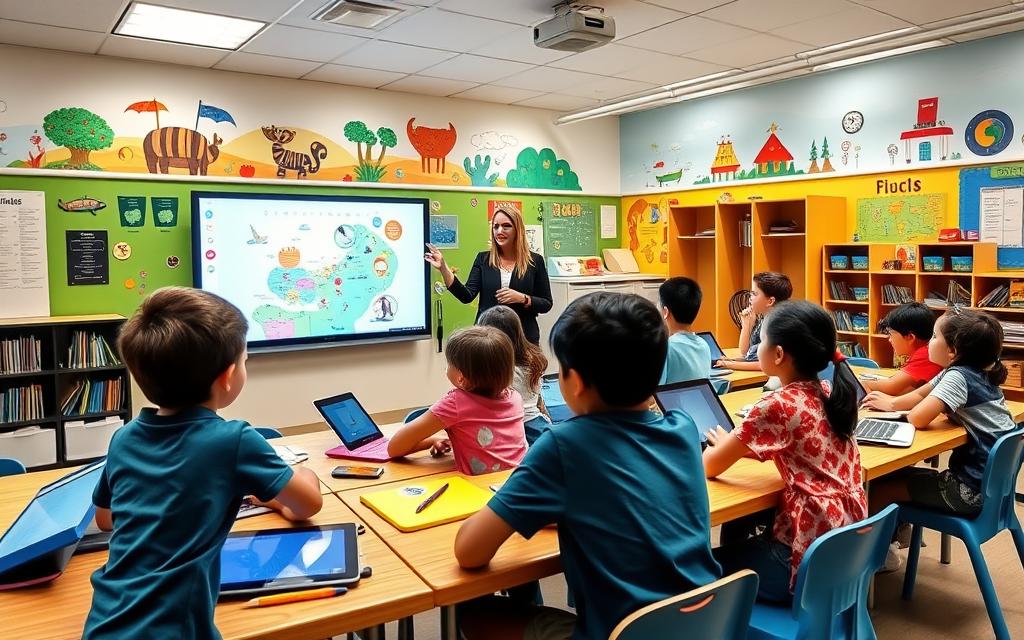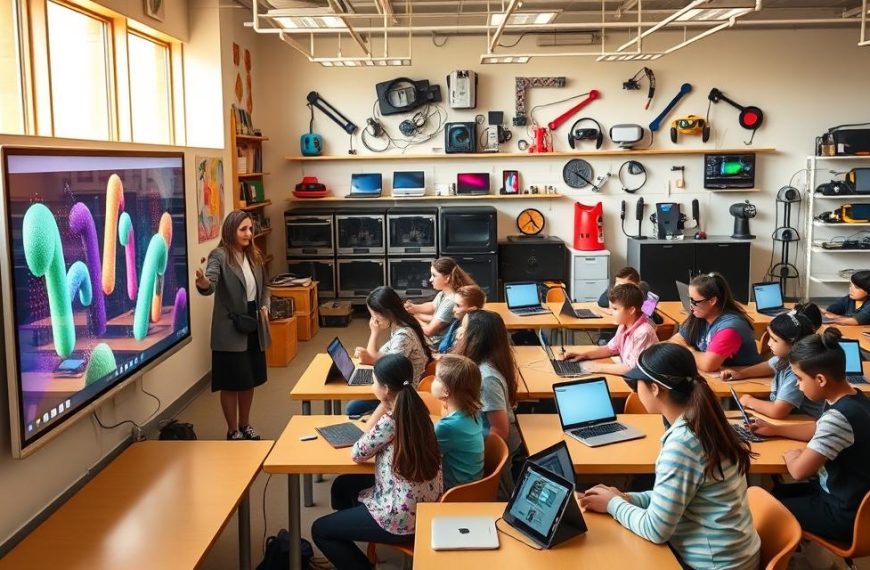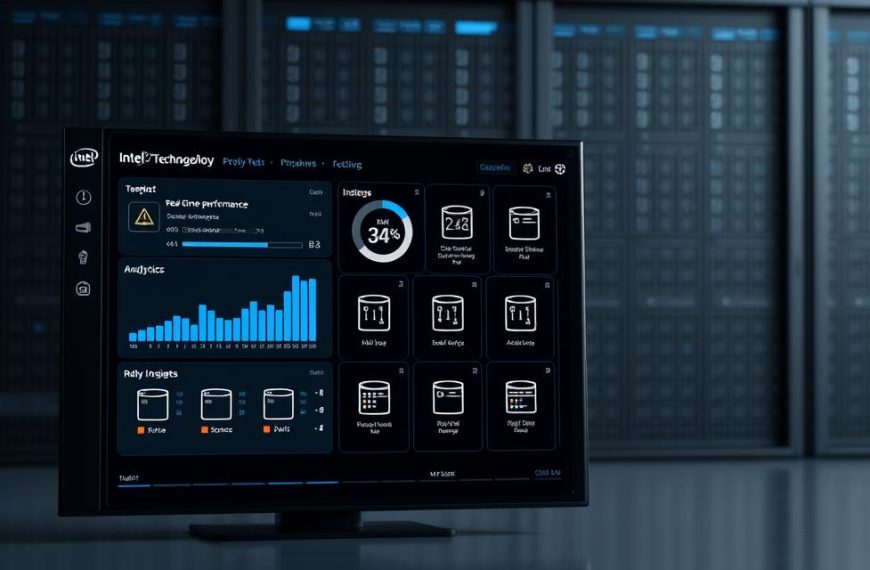Modern education is rapidly evolving, with technology playing an increasingly vital role in the classroom. Today’s students are digital natives, comfortable with using various digital tools and technologies.
Effective learning now involves complementing traditional teaching methods with innovative tools that enhance student engagement and provide personalised learning opportunities.
By embracing technology, educators can create a more inclusive and interactive classroom environment that prepares students for success in a digital future.
The Significance of Technology in Modern Elementary Education
In today’s digital age, technology plays a vital role in shaping the educational experiences of elementary students. The way technology is integrated into the classroom has undergone significant changes over the years.
The Evolution of Classroom Technology
The use of technology in elementary education has evolved substantially, from occasional visits to computer labs to becoming an integral part of daily classroom activities. According to the National Center for Educational Statistics, 45% of public schools now offer one-to-one technology programmes, indicating a significant shift towards personalised learning experiences. This evolution has transformed technology from a supplementary tool to a core component of the learning process.
Preparing Students for a Digital Future
Classroom technology helps students develop crucial digital literacy skills necessary for their future careers. By integrating technology into elementary education, students are prepared for an increasingly digital world by acquiring transferable skills. Early exposure to technology in a structured educational environment teaches students to use digital tools responsibly and effectively. Technology skills are now considered core competencies alongside traditional subjects like reading and mathematics, aligning with modern educational standards and expectations.
| Benefits of Technology Integration | Description |
|---|---|
| Develops Digital Literacy | Enhances students’ ability to use technology effectively |
| Prepares for Future Careers | Equips students with skills necessary for a digital workforce |
| Enhances Learning Experience | Makes learning more engaging and interactive |
As education continues to evolve, the role of technology in classrooms will remain pivotal in shaping the learning experiences of students.
“Technology will become an even more integral part of the learning process, and we must ensure that our students are well-prepared to harness its potential.”
Benefits of Integrating Technology in Elementary Classrooms
The use of technology in elementary education offers a wide range of benefits, from increased engagement to better learning outcomes. By incorporating technology into their teaching practices, educators can create a more dynamic and inclusive learning environment.
Enhancing Student Engagement and Creativity
Technology significantly enhances student engagement through interactive and dynamic learning experiences. It fosters creativity by providing students with new tools and mediums to express their ideas and demonstrate their understanding. For instance, digital art software allows students to explore their creativity in ways that traditional media cannot.
Promoting Collaboration and Inclusion
Collaborative digital tools enable students to work together in new ways, developing important teamwork and communication skills. Technology also makes learning more inclusive by providing accessibility features and alternative ways for students to access and interact with content. This ensures that all students, regardless of their abilities, can participate fully in the learning process.
Supporting Differentiated Learning
Technology supports differentiated instruction by allowing teachers to customise learning experiences based on individual student needs, interests, and abilities. It enables more efficient assessment and feedback, helping teachers track student progress and adjust instruction accordingly. The following table illustrates how technology can be used to support different learning needs:
| Learning Need | Technology Solution |
|---|---|
| Students with disabilities | Accessibility features such as text-to-speech software |
| English language learners | Multilingual resources and translation tools |
| Gifted students | Advanced online courses and project-based learning platforms |
By leveraging these technologies, educators can create a more inclusive and effective learning environment that benefits all students.
10 Effective Ways to Integrate Technology in the Elementary Classroom
Technology integration in the elementary classroom requires a thoughtful and multi-faceted approach. To effectively incorporate technology, teachers must consider various strategies that cater to different learning styles and needs. Here are ten effective ways to enhance the learning experience for elementary students.
Interactive Digital Activities
Creating interactive digital activities is an excellent way to engage students and develop their digital literacy skills. Teachers can use tools like Kahoot and Quizlet to create interactive quizzes and games that make learning fun. For instance, a teacher can create a Kahoot quiz on a historical topic, incorporating images and videos to make it more engaging.
Incorporating Multimedia Resources
Incorporating multimedia resources such as videos, podcasts, and interactive presentations can enhance instruction and appeal to different learning styles. For example, a teacher can use a video on the water cycle to supplement a science lesson, while an interactive presentation can be used to teach a math concept. Effective technology integration involves using a variety of resources to keep students engaged.
Virtual Reality for Immersive Learning
Virtual reality (VR) and augmented reality (AR) can provide immersive learning experiences that bring abstract concepts to life. For instance, VR can take students on virtual field trips to historical sites or places they couldn’t otherwise visit. This can be particularly useful for subjects like history and geography.
Digital Assessment Tools
Digital assessment tools can streamline the evaluation process, provide immediate feedback, and help teachers track student progress more efficiently. Tools like Google Forms and Classcraft can be used to create digital assessments that are both engaging and informative.
Online Collaboration Spaces
Establishing online collaboration spaces can foster teamwork, communication, and shared learning experiences among students. Platforms like Google Classroom and Edmodo allow students to work together on projects, share resources, and communicate with each other.
Digital Storytelling
Digital storytelling tools can enhance literacy instruction and give students creative ways to demonstrate their understanding. Tools like Book Creator and Storybird allow students to create interactive stories that can be shared with the class.
Coding and Computational Thinking
Coding and computational thinking activities can develop problem-solving skills and prepare students for future technological careers. Platforms like Scratch and Code.org provide resources and activities for teaching coding concepts.
Digital Portfolios
Digital portfolios can document student growth and showcase their work to parents and the broader community. Tools like Seesaw and Google Sites allow students to curate their work and reflect on their learning.
Adaptive Learning Programmes
Adaptive learning programmes can personalise instruction based on individual student needs and progress. Tools like DreamBox and Curriculum Associates provide adaptive learning solutions that cater to different learning styles.
Gamification Elements
Gamification elements can increase student motivation and engagement with learning activities. Teachers can use tools like ClassDojo and Classcraft to incorporate game-like elements into their lessons, making learning more enjoyable and interactive.
By implementing these strategies, teachers can create a more engaging, interactive, and effective learning environment for their students.
Essential Educational Apps and Tools for Elementary Teachers
To create an engaging learning environment, elementary teachers need access to a range of innovative educational apps and tools.
Presentation and Interactive Learning Platforms
Interactive learning platforms are revolutionising the way teachers deliver lessons. Nearpod is a standout tool, allowing teachers to create interactive, multimedia lessons with embedded assessments and activities.
Another valuable tool is Flipgrid, which enables students to share their thinking through recorded video responses, enhancing both verbal expression and digital communication skills.
Subject-Specific Applications
Subject-specific apps can make complex concepts more accessible. For mathematics, apps like Math Playground offer interactive practice and visual models to aid understanding.
Literacy apps such as Reading A-Z support reading development through adaptive activities and immediate feedback.
Classroom Management Technology
Effective classroom management is crucial for a productive learning environment. Tools like ClassDojo help teachers organise their digital classrooms, track student behaviour, and communicate with parents.
By integrating these educational apps and tools into their teaching practices, elementary teachers can enhance student learning experiences, promote engagement, and create a more inclusive classroom environment.
How to Integrate Technology Across Different Subject Areas
Integrating technology across various subject areas in elementary education can significantly enhance student learning outcomes. By leveraging technology, educators can create a more engaging, interactive, and inclusive learning environment that caters to diverse student needs.
Technology in Literacy and Language Arts
In literacy and language arts, technology can be used to enhance reading instruction through e-books, audiobooks, and interactive reading platforms that track comprehension and vocabulary development. Digital publishing tools, collaborative writing platforms, and multimedia storytelling applications can support writing instruction, enabling students to express their creativity and develop their writing skills.
Digital Tools for Mathematics Instruction
Mathematics instruction can be enhanced through virtual manipulatives, interactive problem-solving activities, and adaptive practice programmes that adjust to student performance. Technology can make abstract mathematical concepts more concrete and visual, helping students develop a deeper conceptual understanding.
Enhancing Science and Social Studies with Technology
Science instruction can be transformed through virtual experiments, simulations, and data collection tools, allowing students to engage in scientific practices in new ways. Social studies can be brought to life through virtual field trips, interactive maps, primary source digital archives, and connections with classrooms around the world, providing students with a more immersive and interactive learning experience.
By integrating technology across different subject areas, educators can support cross-curricular projects that develop 21st-century skills, such as critical thinking, collaboration, and creativity. It is essential to select technology tools that align with specific learning objectives, rather than using technology for its own sake.
Overcoming Challenges When Integrating Technology
Integrating technology in elementary classrooms can be challenging, but there are effective strategies to overcome these obstacles. Teachers and administrators must work together to address the common issues that arise during technology integration.
Addressing Limited Resources and Access
Schools often face limited resources and unequal access to technology. To address this, educators can implement rotation stations and partner work, ensuring all students have opportunities to engage with technology. Seeking grants and community partnerships can also help bridge the digital divide, promoting digital equity.
Managing Screen Time Concerns
Concerns about screen time are valid, but with balanced technology use, educators can mitigate these issues. Teachers should establish clear guidelines for technology use, promoting healthy habits such as regular breaks and proper ergonomics. By differentiating between passive consumption and active, educational engagement, educators can ensure that technology enhances learning.
Supporting Teachers with Professional Development
Ongoing professional development is crucial for teachers to effectively integrate technology into their classroom practices. This can include formal training, peer mentoring, and self-directed learning opportunities. By supporting teachers, schools can ensure that they are confident in using technology to enhance students’ educational experiences.
Real-World Examples of Successful Technology Integration
Technology has transformed the elementary classroom, offering new avenues for engagement and education. This transformation is evident in various innovative approaches that are being adopted worldwide.
Digital Field Trips for Experiential Learning
Digital field trips have revolutionised experiential learning by enabling students to visit museums, historical sites, and natural wonders virtually. Platforms like Google Expeditions and Discovr allow teachers to take their students on immersive virtual tours, enhancing their understanding and engagement with the subject matter. For instance, students can explore the Great Barrier Reef or visit the Louvre Museum, experiencing these locations in detail without leaving the classroom.
Gamified Learning for Enhanced Student Participation
Gamified learning approaches have significantly increased student participation and motivation. By incorporating elements like points, badges, and leaderboards, teachers can create engaging learning experiences. For example, platforms like Classcraft and Kahoot! enable teachers to develop interactive lessons that make learning fun and competitive. This approach has been shown to improve student outcomes across various subjects, from mathematics to language arts.
Conclusion: Creating a Balanced Approach to Classroom Technology
Ultimately, the key to successful technology integration lies in striking a balance between digital tools and traditional teaching practices. This approach enhances student learning and prepares elementary students for future academic success and careers in an increasingly digital world. Teachers should start small, experiment, and gradually expand their technology use as they build confidence and expertise. Ongoing professional learning and collaboration with colleagues are crucial for improving technology integration practices. By involving students in the process and leveraging their natural interest in digital tools, teachers can create engaging, effective, and equitable learning environments for all students.


















